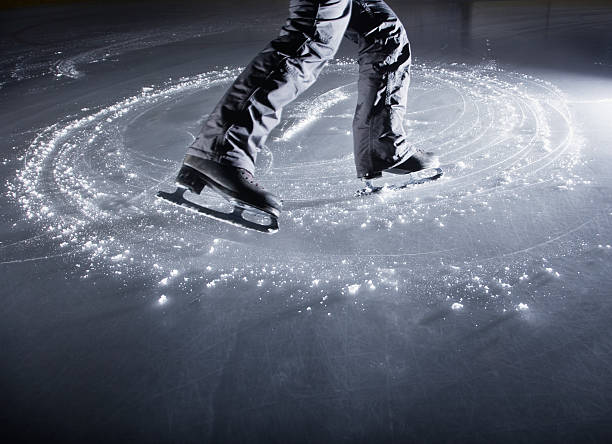How thick is the Ice on a Hockey Rink?
How thick is the Ice on a Hockey Rink? In the ice hockey world, the thickness of the ice in a hockey rink is a crucial factor that significantly impacts the game. Maintaining the perfect ice thickness ensures a smooth, fast, and safe playing surface. But how thick is the ice on a hockey rink, and why is this thickness so important? Let’s delve into the details.
Table of Contents
ToggleStandard Ice Thickness for Hockey Rinks
In professional hockey rinks, such as those used in the NHL, the ice is typically maintained at a thickness of about 1 inch (2.54 cm) to 1.25 inches (3.18 cm). This standard ensures optimal conditions for gameplay, balancing the need for durability and a smooth skating surface.

How thick is the Ice on a Hockey Rink? (Factors Affecting Ice Thickness)
- Safety and Performance: Thicker ice can withstand the wear and tear from players’ skates, sticks, and pucks. It also helps prevent cracks and divots that could affect player safety and game performance.
- Temperature Control: Ice thickness is influenced by the underlying refrigeration system. Maintaining a consistent temperature is key to preserving the ice’s integrity and preventing it from becoming too soft or too hard.
- Arena Conditions: Factors such as humidity, the number of games played, and maintenance schedules can affect ice thickness. Regular resurfacing with a Zamboni helps maintain the ideal thickness throughout the game.
How thick is the Ice on a Hockey Rink?: Ice Thickness in Different Leagues
While the NHL maintains ice at about 1 to 1.25 inches, other leagues and recreational rinks might have slightly different standards. For example, recreational rinks often maintain ice thickness between 1.25 inches (3.18 cm) and 1.5 inches (3.81 cm) to accommodate less frequent maintenance and varying skill levels of skaters.
The Ice-Making Process
- Foundation Layer: The process starts with a thin layer of water that freezes to create a bond with the concrete or sand base.
- Building Up Layers: Several thin layers of water are sprayed and frozen, gradually building up to the desired thickness.
- Painting and Marking: Lines and logos are painted onto the ice surface, followed by additional layers of ice to seal and protect the markings.
How thick is the Ice on a Hockey Rink?: Maintaining the Perfect Ice Thickness
- Regular Resurfacing: Using a Zamboni to shave the ice and add a fresh layer of water helps keep the surface smooth and at the proper thickness.
- Monitoring Temperature and Humidity: Ensuring the arena maintains the right environmental conditions prevents ice from becoming too soft or too brittle.
- Routine Inspections: Regular checks for cracks, divots, and other imperfections allow for timely repairs and maintenance.
Importance of Proper Ice Thickness
Proper ice thickness is vital for several reasons:
- Player Safety: Thicker ice reduces the risk of injuries from falls and collisions.
- Game Speed and Quality: Optimal ice thickness ensures a smooth surface, allowing for fast-paced gameplay and precise puck movements.
- Longevity of the Ice: Maintaining the right thickness helps the ice endure the rigors of multiple games and practices without degrading.
Conclusion
How thick is the Ice on a Hockey Rink? Understanding how thick the ice on a hockey rink should be highlights the meticulous care that goes into creating the perfect playing surface.
Click to read details about Ice Rinks.
Whether for professional leagues like the NHL or local recreational rinks, maintaining the ideal ice thickness is essential for safety, performance, and the overall quality of the game. By adhering to these standards, ice rink operators ensure a superior experience for players and fans alike.
FAQ’s
What Causes an Ice Rink to Crack? Cracks in an ice rink can result from several factors. Here are the main causes and how to address them:
- Temperature Fluctuations
- Cause: Sudden changes in temperature can cause the ice to expand or contract, leading to cracks.
- Solution: Maintain a consistent ambient air temperature and ice surface temperature to prevent fluctuations.
- Improper Ice Thickness
- Cause: Ice that is too thin or uneven can crack under pressure from skaters or hockey players.
- Solution: Ensure the ice is maintained at a thickness of 1-1.25 inches (2.54-3.18 cm) and regularly check for evenness.
- High Humidity Levels
- Cause: Excessive humidity can cause the ice to become soft or develop cracks.
- Solution: Use dehumidifiers to manage indoor humidity levels and prevent condensation.
- Poor Ice Maintenance
- Cause: Lack of regular ice resurfacing can lead to the development of cracks.
- Solution: Regularly use a Zamboni or similar machine to resurface the ice and repair minor cracks.
- Heavy Traffic or Excessive Load
- Cause: Excessive weight from equipment or large crowds can stress the ice surface.
- Solution: Manage ice usage to avoid excessive load and distribute weight evenly.
- Subsurface Issues
- Cause: Problems with the concrete slab or underlying refrigeration system can cause uneven cooling and cracks.
Solution: Regularly inspect and maintain the refrigeration system and ensure the concrete slab is level and free from damage.
How to Keep an Ice Rink from Melting?
- Maintain Refrigeration Systems: Ensure that the refrigeration pipes under the ice are working properly. These pipes circulate a chilled brine solution to keep the ice frozen.
- Control Temperature: Keep the rink’s ambient air temperature between 12.8°C to 18.3°C (55°F to 65°F). This balances comfort for skaters while keeping the ice solid.
- Manage Humidity: Use dehumidifiers to reduce moisture in the air, preventing condensation and keeping the ice surface from becoming slushy.
- Regular Ice Resurfacing: Use a Zamboni or similar machine to regularly resurface the ice, smoothing out imperfections and applying a thin layer of warm water to keep the surface in good condition.
- Insulate the Rink: Ensure insulation under the concrete slab and around the rink to prevent heat from escaping and maintain ice quality.
What Is Underneath an Ice Rink?
Underneath an ice rink, you’ll find a concrete slab for support, refrigeration pipes for cooling, insulation to retain cold, a drainage system for excess water, and structural support beams for stability. These components work together to maintain the quality and safety of the ice surface.
How Rinks Stay Frozen: Refrigeration pipes circulate chilled brine, insulation prevents heat loss, and temperature management keeps the ice solid at -4.4°C to -3.3°C.
Middle of the Rink: The Center Ice area, where the faceoff circle is located and central to the rink’s design.






